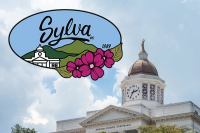Old hospital to be repurposed into senior housing
Haywood County’s seniors are one step closer to having more affordable housing options.
County commissioners last week agreed to sell the old hospital to Fitch Development Company for $1.275 million. They will then undertake the mammoth task of turning the old four-story brick hospital into one-and-two bedroom apartments for senior citizens who need affordable housing.
The number of units isn’t finalized, but County Manager Marty Stamey has said that current plans call for 53 units.
The building currently serves as offices for the Department of Social Services and central offices for Haywood County Schools, which are moving out.
County Attorney Chip Killian said that, after interviews and negotiations with Fitch, he’s confident that they’re the right firm for the complex job, which will require jumps through a number of funding and regulatory hoops. To make the project economically feasible, Fitch needs to land housing tax credits, a small county loan and national historic designation.
“These things are very complicated,” said Killian. “I think everybody feels real good about Fitch Development Company in that they’re very motivated and competent to do this kind of project.”
The hospital is a historic entity that holds a place in state history as North Carolina’s first county hospital.
Killian told commissioners that, with their approval, the purchase price is set but closing won’t take place before March 2012.
The Smoky Mountain Center, which occupies a building at the rear of the site, will remain.
County to sell old hospital for $1.2 million
Haywood County’s old hospital is set to get a new life after commissioners agreed last week to sell the building for use as low-income housing for the county’s senior citizens.
Following discussions in closed session at their Nov. 15 meeting, Commissioner Mark Swanger made a motion to sell the building to Fitch Development company for $1.275 million.
The sale, however, is contingent on the development company reaching several different benchmarks before the deed is handed over.
“There’s a lot of things that have to happen,” explained interim county manager Marty Stamey, one of which is garnering a historic property designation and listing on the National Register of Historic Places.
The company would have to apply for tax credits from the N.C. Housing Finance Agency. If the buyers can jump through those hoops, the county has agreed to front them a 20-year, $159,000 loan at 2 percent interest to get the project off the ground, and increase its competitiveness for the tax credits. Under current plans for the building, that would amount to $3,000 per unit.
Those figures might change, as the final number of units to be housed in the former hospital hasn’t been determined.
This offer is contingent on the fact that all these things come into play,” said Stamey, “but [on the current timescale] the developers would start environmental remediation and construction in April 2012.”
The building is currently home to the county’s Department of Social Services and the Board of Education. While DSS has found a new home in Clyde’s former Wal-Mart building, the Board of Education will now have to find a new space before construction gets under way.
The current plan for the building calls for 53 units. As construction draws closer, an analysis will be done to assess the current needs of the county. The results of that study may change the type and number of units.
The offer from Fitch was one of two bids presented to commissioners and offered the highest purchase price for the property.
Stamey said he sees this as a win-win for the county, who will not only get a good price for the building and pull in more tax revenue, but a valuable piece of Haywood County history will be preserved and maintained. And, elderly residents will find the housing they need.
“There’s a serious lack of elderly housing that’s affordable for seniors in our area,” said Stamey. “A lot of counties and municipalities are doing this across the state, and one of the worst things you’d want to see is for the hospital to sit up there and be a dinosaur and just deteriorate away. It has so much historic value to so many people.”
Built in 1927, the massive brick building was the first county hospital in North Carolina. It was renovated in 1955, but a full-scale renovation would, today, cost about $6 million, more than the county could afford on its own. The sale would not include the site’s excess parking or the building that now houses the Smoky Mountain Center.
Cherokee hospital uses art to build community
When the Eastern Band of Cherokee Indians took over the Cherokee Indian Hospital from the Indian Health Service in 2002, the hospital’s administrators faced a challenge.
They wanted the hospital to feel like it belonged to the community, but they inherited a building that was far from welcoming.
“People wanted to be surrounded by Cherokee things,” said Jody Adams, the hospital’s director of community relations.
The hospital’s motto “Ni-hi tsa-tse-li” means “It belongs to you,” but there was nothing Cherokee about the white walls and clinical feel inside the hospital.
Adams formed a culture committee comprised of hospital staff and community elders and turned to the Cherokee Preservation Foundation for grant funding. Susan Jenkins, executive director of the Foundation, said the hospital’s makeover mission was exactly the kind of project the organization wants to fund.
“When they came to us, we thought it was a great fit, because they would have to work with the elders and the community and reach out to the local artists,” Jenkins said.
The Foundation has contributed $20,000 per year to the hospital’s cultural makeover. Adams has overseen the projects, which partner with local artists to transform the interior spaces of the building into venues for displaying Cherokee art and culture.
When you walk in the main entrance, you can see the impact right away. A large mural in the waiting area combines Cherokee words written in the syllabary and their English translations. The television monitors in the waiting rooms show cultural documentaries instead of Fox News or CNN.
Look deeper in the hospital and you’ll see walls filled with the portraits of elders, or hand-painted with animal tracks.
Jenkins has been impressed with the hospital’s transformation. An enrolled member of the Choctaw tribe of Oklahoma, she has seen enough of IHS hospitals to know the difference.
“Now when you go in there you get a sense that ‘Oh gee, this is my place,’” Jenkins said.
Room by room, Adams’ committee has targeted rooms for overhauls. They started with the hospice room, a place where patients come to live their last days in comfort surrounded by family. Then they found an artist to design a traditional Road to Soco Mountain pattern, and they filled a hallway with it.
The waiting area to the dental clinic has a wall-sized mural of a mountain stream. Another room shows the process of making river cane baskets.
“One of the things we wanted to do with every room is teach something,” Adams said.
Adams said the latest project is to transform the hospital’s inpatient rooms.
“Most of the inpatient rooms still have that IHS feel,” Adams said. “The research shows the rooms are a factor in the healing process.”
Adams wanted new ideas for the rooms, so she turned to Western Carolina University’s interior design program for a partnership.
“I wanted new ideas. I wanted to show the nurses and the providers that there are a lot of options. We don’t have to be a facility full of white rooms,” Adams said.
Candace Roberts, a WCU interior design professor, along with her students created a portfolio of potential design schemes for the inpatient rooms and along the way they met with elders to learn about the Cherokee culture. The first transformed inpatient room was finished last week, but Adams said the transformation of the hospital will continue.
Promoting culture
Filling the otherwise institutional walls of the Cherokee hospital with cultural themes is just one of many projects funded by the Cherokee Preservation Foundation. The Foundation was formed in 2000 with a mission to preserve Cherokee culture, enhance economic development and improve the environment using casino revenue. Since 2002, the Foundation has given out more than $47 million in grants throughout the region, which in turn have generated more than $100 million when combined with matching money.





